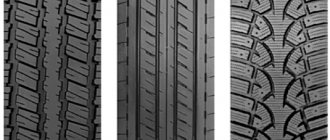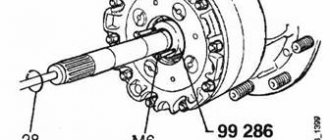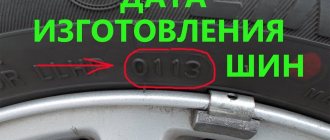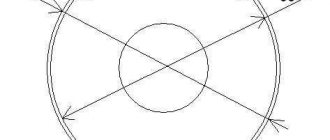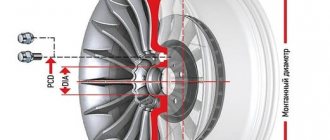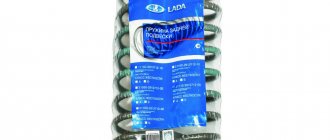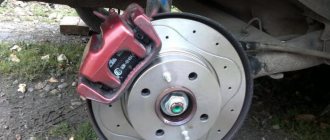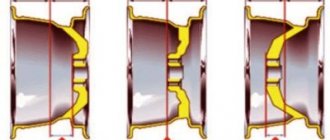Marking of car wheel rims is divided into two types - standard and additional. Standard information includes information about the width of the rim, the type of edge, rim split, mounting diameter, ring lugs, offset, etc.
As for additional markings, this includes information about the maximum permissible load, the maximum permissible tire pressure, information about the methods of manufacturing the disk, information about the international certification of a particular disk. However, not every car rim will have all the information listed above. Most products provide only some of the information provided.
How are wheels for passenger cars marked?
The entire range of car wheels has standard markings. Certification in European countries is carried out in accordance with the officially confirmed UNECE 124 regulation. The marking is a certain set of symbols and numbers.
Failure to comply with these norms and standards in relation to at least one of the parameters threatens accelerated tire wear. This at high speed, during sharp braking or on a sharp turn is fraught with the destruction of rubber and an emergency situation on the road.
Humps
Another parameter that may or may not be present in the disc marking is the letter “H”. It denotes the shape and presence of humps. Hamp, translated into Russian, is a ledge. These protrusions are necessary to secure tubeless tires and hold air in the cylinder. There are several configurations of the annular protrusion:
- H – there is only one annular protrusion on the disk;
- H2 – there are two identical annular protrusions on the rim;
- FH – flat hump;
- CH – combined hump (Combi Hump);
- AH – Asymmetric Hump.
If instead of the marking “H” there is a liter “X”, then the disc is non-separable and without ring protrusions.
Take into account the rules for deciphering wheel rim parameters. Thus, you will be able to purchase disks of the required design. As a result, the car will meet factory specifications and delight the owner.
Where is the disc marking located?
The marking on a wheel rim applies to any element of it, regardless of the technologies and materials used in manufacturing. It is located on the outer or inner side of the front part of this element of the car. For aesthetic purposes, manufacturers often apply markings inside the panel.
Depending on the model, data is squeezed out in different places, but basically their location is in the free spaces between the disk mounting holes. Sometimes technical information is located on the outside of the wheel rim.
Vilet
Most tire centers and online stores sell exclusively Chinese wheels of the brands Replica, Nitro, etc. Do they meet safety standards?
As a rule, wheels presented in serious stores undergo mandatory certification and are approved for use. Don’t be shy, ask merchants for certificates for their goods.
What parameters are indicated?
All wheels are marked according to generally accepted standards. This applies equally to both cast and stamped products. To understand the markings of car wheels, you need to have an idea of their structure.
The wheel rim consists of the following parts:
- 1 - diameter of the annular part of the rim;
- 2 - central axis of rotation;
- 3 — rim landing width;
- 4 — annular protrusion (hump);
- 5 — rim mounting groove;
- 6 - shelf;
- 7 - edges;
- 8 — diameter of the central (hub) hole;
- 9 — diameter of the disk mounting plane;
- 10 - diameter of the circle of the centers of the mounting holes;
- 11 — disk mounting plane;
- 12 - x-factor;
- 13 — wheel offset;
- 14 — axis of symmetry of the disk.
A code of numbers and symbols does not always characterize all parameters of a particular product without exception. But the manufacturer is obliged to provide the most important characteristics to the consumer.
For greater clarity, we will analyze the wheel rim markings using a specific example - this will be code 9JX19ET41. We will also consider additional parameters, non-standard options, designation ranges and other nuances.
Rim width
The first number (in our case it is 9) is the distance between the inner side surfaces of the wheel rims. The numerical value is indicated in inches. For passenger cars, depending on the car model, it ranges from 5-12.5 inches.
This is an important characteristic and should be taken into account when choosing tires, since each tire has a specific rim width range. Ideally, the latter should tend to the average of this range.
Rim edge type
The letter J in the example is the type of rim edge, or more precisely, the shape of its flange. This is where the contact between the tire and the wheel occurs. There are quite a lot of variations in the design of the edge shape. Among the most common:
- J;
- P;
- D;
- B;
- K;
- JK;
- JJ;
- J.
Each letter corresponds to one or more characteristics. From the technical side, the latter carry the description:
- radius of curvature;
- contour profile shape;
- shelf angle;
- shelf height, etc.
The rim lip type J shown in the example is most often found in passenger cars. The range of passenger cars with all-wheel drive is equipped as standard with wheels with code JJ.
The type of wheel rim edge directly affects the installation, balancing, and resistance of the rubber to extreme situations. Some disks with different flange shape designations have similar parameters, but this does not mean that they are interchangeable. To avoid problems, always select only the manufacturer's recommended rim edge.
Possibility of disassembly (detachable)
The letter X in the example means that this rim is one-piece, that is, it cannot be disassembled. The occurrence of the “—” symbol on other types of disks indicates the disassembly of this unit. Additional differences between the second and the first are increased weight and rigidity.
The X designation also indicates that the disc is designed to work in tandem with an elastic tire. This is typical mainly for passenger cars. In heavy trucks, a rigid, split disk design is used.
Mounting diameter
This term refers to the diameter of the wheel rim for tires in inches. In the example given, its value is 19. Among car enthusiasts, there is another name for this parameter - disk radius.
The mounting size of the tire must exactly match the diameter of the wheel rim. Standard values for this parameter for cars and SUVs are in the range of 13-21 inches.
Disc offset
Offset is the size in millimeters between the point of contact of the disk and hub with the center of the cross section of the wheel. The value can be zero (ET0), positive (ETXX) or negative (ET-XX). The number XX of the rim of a particular car must correspond to the parameters recommended by the manufacturer.
In the above example, the positive disc offset is ET41. It is very important that this parameter is as close as possible to the characteristics declared by the manufacturer. Otherwise, in emergency conditions, the disk may not withstand the load with all the ensuing consequences.
Ring lugs
On many rims there is such a designation as an annular protrusion - a hump (a unit designed to fix a tubeless version of a tire and prevent air from escaping when the rubber is exposed to external forces). The parameter contains the letter H, other symbols and numbers. For example, the FH code can be deciphered as follows: a flat hump, truncated in height on one side of the disk.
Table of the most common types of ring protrusions:
| Designation | Decoding |
| H | simple hum inside or outside the disk |
| H2 | dual system located on both sides |
| FH | flat version with truncated height |
| A.H. | asymmetrical system |
| CH | combined variation of hump |
| FH2 | double flat version |
| EH+ | extended variety of hampa |
| EH2 | extended twin system |
Mounting holes
The marking of the fastening unit is deciphered very simply: the first number indicates the number of holes, the second number is the diameter of the circle where these holes are located in millimeters. There are quite a lot of bolt pattern (PCD) options, with the first value being in the range of 4-6 pieces, the second ranging from 98 to 139.7 mm.
Determining the compliance of a bolt assembly by eye is not recommended. A miss of even a couple of millimeters is dangerous due to misalignment of the wheels and subsequent beating. If the outcome is unfavorable, spontaneous unscrewing of the fastening elements may occur.
Hub Bore Diameter
The diameter of the central mounting hole of the disks is indicated in millimeters, as code dXX. In passenger cars, its value is in the range of 50-70 mm. Wheels are selected in strict accordance with the technical regulations of the car.
Additional parameters and non-standard marking options
In addition to the main characteristics of the marking of car rims, there are additional (but no less important) parameters, which, however, are not related to the size of the wheel.
The designation MaxLoadХХХ is nothing more than the maximum permissible weight on wheels, where ХХХ is kilograms or pounds, depending on the make of the car. When installing wheels in a manner that does not comply with the described parameter, there is a risk of increased load on this structural element and deformation of the latter, even with a slight impact.
In addition, additional markings on discs may contain the following information:
- TUV, SAE, PCT, ISO - quality control, product manufacturing standard;
- MaxLoadХХХlbs - the maximum permissible load on the wheels, where, depending on the car model, XXX is the maximum kilograms or pounds;
- PCDХХХ/Х - additional bolt pattern size;
- MaxPSIХХCold - maximum pressure (XX) of a cold tire.
Sometimes the manufacturer indicates additional information on the disk that reveals the technical features of the product manufacturing technology. For example, this could be a disc color coding (to more accurately match the color of the car). It consists of one or two Latin characters.
Table for decoding the color scheme of rims:
| Designation | Decoding |
| W.F. | polished white |
| W | plain white |
| MGM | dark grey |
| M.B. | smoky black |
| HPB | dark silver |
| FWF | white partially polished |
| GMF | dark gray fully polished |
| GF | fully polished gold |
| CH | chromium |
| S(HP) | silver |
| SF (HS) | fully polished silver |
| G.M. | gray with a dark tint |
| G | gold |
| FGMF | partially polished silver |
| FSF | partially polished silver |
| HPL | silver with polished rim |
| MBF | smoky black fully polished |
| M.W. | matte white |
Other designations besides those listed are not very important to the car owner. It can be:
- styling specification;
- product release date;
- Country of Origin;
- technological information and so on.
How to take your own rim measurements
In order to obtain accurate data in inches, you must complete several sequential steps:
- release air from the tire;
- remove the tire, freeing access to the rim;
- using a tape measure, calipers or ruler, take measurements;
- it is necessary to measure the distance from edge to edge, maintaining perpendicularity;
- convert the obtained data into inches (divide by 25.4);
- Place the tire in its original place and inflate the air if the wheel is not intended to be completely replaced.
Each rim is about a quarter smaller than a tire, this is absolutely normal. For example, if the tire width is 28.5 centimeters, then the rim width can be 213.7 mm (75%). If you divide the data by 25.4, you get a parameter of 8.5 inches.
Practical advice
Markings on rims are not just a set of symbols and numbers. To avoid unpleasant situations during purchase, installation and operation, additionally pay attention to the following points:
- A common mistake made by car owners is purchasing wheels with bolt patterns that differ from the standard ones. If you miss the PCD by just a few millimeters, there is a risk of wheel runout and rapid wear of the hub bearings.
- The highest quality type of wheel painting is powder enamel coating. The latter is applied using electric current, and the paint layer is stable and uniform.
- When mounting the tire, try not to scratch the rim. Even minor damage can lead to rust.
- When purchasing new wheels, pay special attention to the presence/absence of paint chips. This will also prevent metal corrosion in the near future.
- When purchasing disks, pay attention to the planes of their sides. They should not have dents or uneven movement relative to the axis during rotation (checking is carried out on a tire changing machine).
- Never install tires with a smaller diameter on rims. Such experiments threaten with negative consequences.
- It is not recommended to adjust holes for wheel mounts by boring/drilling them. This modification reduces the safety of the vehicle.
- The disk fasteners used must be complete. Installation using any “suitable” bolts and nuts risks spontaneous unscrewing of the latter and an emergency situation on the road.
- The value of the PCD parameter in the absence of markings on the disk can be found using a caliper. But if such a need arises, it is still better to contact a specialist.
- Do not install wheels with a non-standard offset on your car. Although reducing the latter increases the track, increases ride stability and gives the car a stylish appearance, it also entails overloading the hub and suspension bearings.
To learn how to decipher disk markings, watch the following video:
Knowing how to decipher wheel rim markings will be useful to any car enthusiast. After reading this article, you will be able to choose the right wheels for your car without consulting a specialist. Remember just a few symbols so that you can decipher them correctly.
Operating instructions or personal measurements
It’s even easier for the car owner if he has the vehicle’s operating instructions. The algorithm of actions is very simple: open, study, select new disks in accordance with the manufacturer's recommendations. It is almost impossible to make a mistake in this case.
However, not all motorists are so lucky. Let's say there are no instructions, the car is old, and non-original wheels were installed by the previous owner - then there is no information at all. It's OK. There is always a backup plan for this case. Namely, independent actions.
